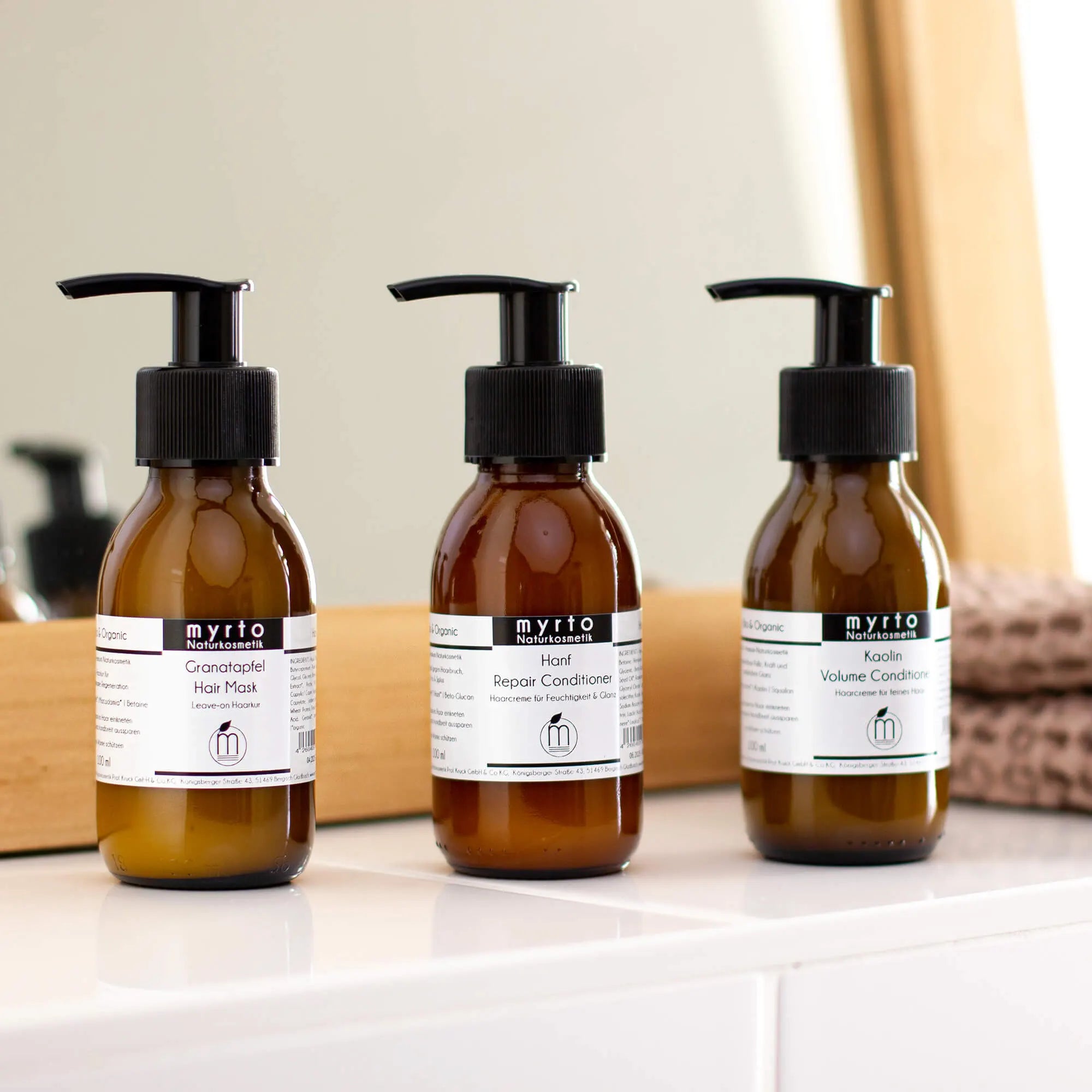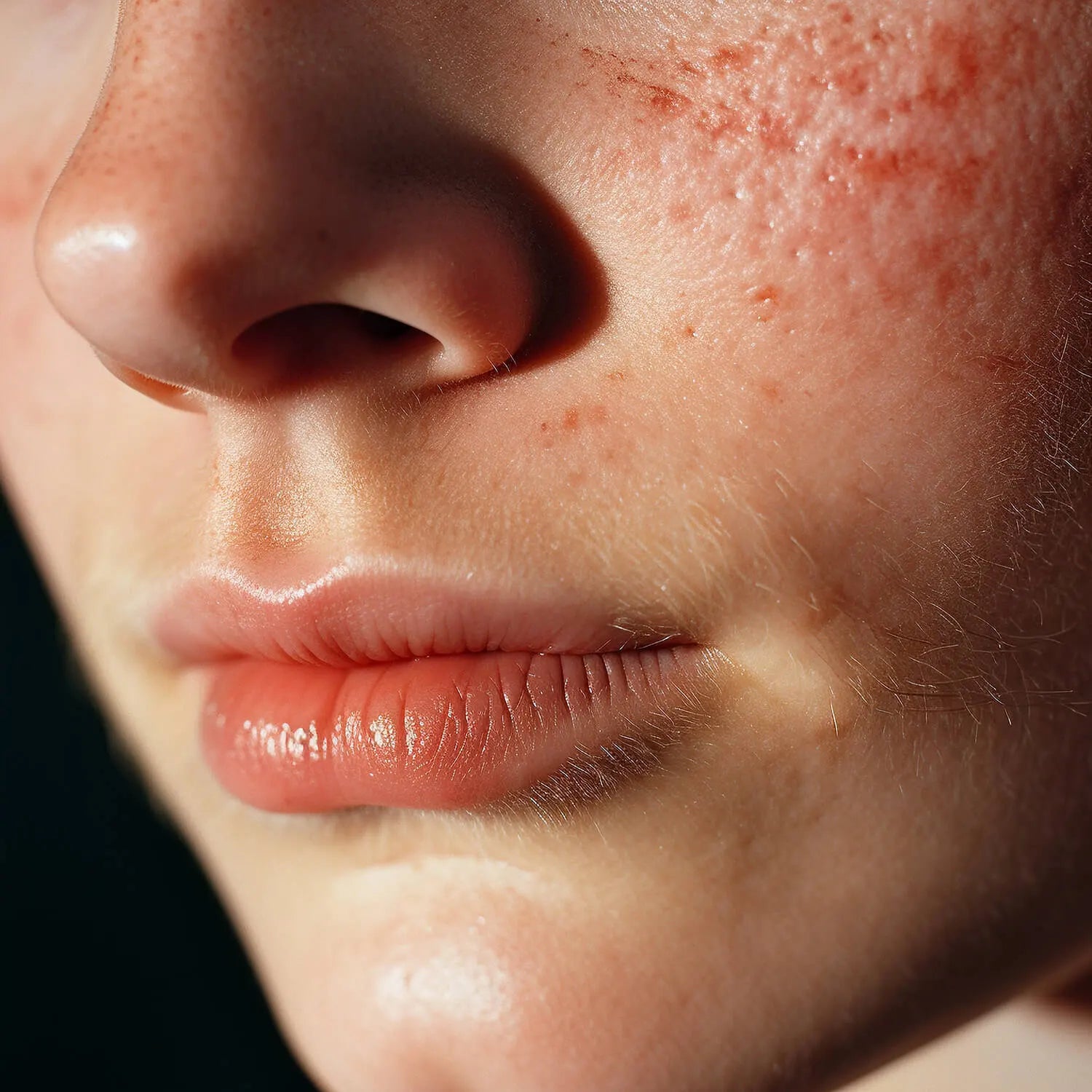
How do I find a high-quality conditioner?
Depending on its richness and consistency, a conditioner is also called a rinse, hair treatment or hair cream. A wash-out conditioner is designed to make hair smooth, shiny and easier to comb after washing. It is designed to smooth the roughened cuticle of the hair fiber, prevent hair breakage and split ends, and protect against damaging external influences such as heat or dry heating air. A leave-in conditioner is not washed out. It can be used on wet or dry hair. In addition to its intensive care effect, a leave-in conditioner is also excellent for hair styling, for example to define waves or to beautifully bundle curls.
4 harmful conditioner ingredients
In addition to care ingredients such as oils and proteins, almost all conditioners also contain chemicals that damage hair and scalp, endanger health or pollute the environment. This particularly applies to silicones, quaternary ammonium compounds (polyquats), hormonally active preservatives such as parabens, environmentally harmful microplastics, drying alcohol or harmful fragrances and dyes with an increased allergy potential.
-
✖ Silicones
Most conditioners still contain silicones. Silicones give hair shine, smooth the damaged hair surface and make hair easier to comb. However, silicones seal the hair surface and make the hairline look greasy and flat if used for a long time (build-up effect). Most silicones are difficult to remove even with aggressive shampoos. Silicones are synthetic, i.e. a petroleum derivative. Silicones are hardly biodegradable. They are increasingly polluting our rivers, lakes and seas.
You can identify silicones in your conditioner in the ingredients list (INCI) by the endings "-cone", "-xane" or "-conol". Examples are dimethicone, dimethiconol, cyclomethicone or cyclopentasiloxane.
-
✖ Quats / QAVs / Polyquaternium
Quats (quaternary ammonium compounds or QACs or polyquaternium) function primarily as synthetic film formers in shampoos and conditioners that are advertised as "silicone-free". QACs are easier to wash out than silicones. They make the hair easy to comb, soft and counteract static charge in the hair. Similar to silicones, there can be a build-up effect.
Quats irritate the scalp and mucous membranes, have an allergenic and drying effect. They accumulate in the cell membranes of living organisms and can affect the cell membrane. For this reason, they are also used as a biocide in disinfectants. QACs are hardly biodegradable. Conditioners containing QACs make hair greasy more quickly. Due to the build-up effect, they flatten the hairline and destroy any volume in a hairstyle. Adding moisturizers or oils afterwards does not change the problem. After stopping using conditioners containing QACs, the hair underneath is usually straw-like, stubborn and damaged.
You can recognize quaternary ammonium compounds in the ingredients list of your cosmetics by the endings "-onium chloride" (e.g. cetrimonium chloride, behentrimonium chloride) or "-quaternium-(number)" (e.g. polyquaternium-7, quaternium-80). There are other QACs such as guar hydroxypropyl trimonium chloride and distearyl dimethyl ammonium methosulfate, which are not quite as irritating to the skin as the ones mentioned above, but have the same problems in a milder form.
-
✖ Microplastics
Microplastics are used as a cheap filler in conditioners, which also gives hair a silky feel, makes it easier to comb and protects it from the heat of a hairdryer. Unlike silicones and polyquats, microplastics are easy to wash out and do not damage hair or scalp.
However, plastic is biopersistent and hardly degradable in the environment. It enters lakes, rivers and seas via wastewater, where the plastic enters the food chain. Animals can die painfully from it, and in the human body it promotes inflammation in the intestines and liver, as well as the development of cancer. Plastics are extremely long-lasting in the environment, can last for hundreds of years and are one of the biggest environmental problems of our time.
Microplastics can hide behind these INCI names, among others: Acrylates Copolymer / Acrylates Crosspolymer, Nylon–(number), Polyacrylates, Polyethylene (PE), Polyethylene Terephthalate (PET), Polymethylmetharcylate, Polypropylene (PP), Polystyrene (PS).
-
✖ Sulfates
Sulfates are the most commonly used surfactants - also in conditioners. These aggressive detergents, synthetically produced from petroleum, dry out the scalp severely. They cause numerous scalp complaints such as burning, itching or redness. Increased greasing is also often a compensatory reaction of the scalp to the strong degreasing effect of hair care products containing sulfates. Sulfates can trigger allergic reactions and are also suspected of being carcinogenic. Sulfates on the ingredients list include sodium laureth sulfate, sodium lauryl sulfate, ammonium lauryl sulfate, ammonium laureth sulfate and sodium myreth sulfate.
What makes a high-quality conditioner?
Instead of silicones, polyquats, microplastics or sulfates, high-quality organic conditioners contain only natural and skin-friendly ingredients such as cold-pressed oils, vegetable proteins and antioxidant plant extracts for optimal care.
-
Organic shea butter instead of denatured, emulsifying palm oil consistency agents
Almost every conditioner contains significant amounts of cetyl alcohol, stearyl alcohol or cetearyl alcohol. These cheap, industrially produced consistency enhancers made from denatured, ecologically controversial palm oil tend to make fine hair look stringy and weigh down the roots. Instead of such inferior fillers, good organic conditioners contain high levels of natural organic shea butter and cold-pressed, organic plant oils. -
emulsifier-free formulation
A high-quality conditioner should be free of aggressive surfactants and emulsifiers. Why? Emulsifiers combine aqueous and oily substances. As a side effect, however, common emulsifiers also react with the protective and hair-smoothing lipids (fats) on the hair fiber and dissolve them (wash-out effect). The roughened, porous surface of the hair fiber promotes drying out and the penetration of environmentally-caused pollutants into the hair.
In contrast to conventional conditioners with denatured fillers, organic conditioners without emulsifiers are rich in natural organic plant oils with their unsaturated fatty acids, antioxidants and vitamins in a natural composition. They provide natural shine, smooth and regenerate damaged, roughened hair fibers, define curls and waves. They strengthen the hair structure sustainably and prevent split ends.
-
Hydrating, protective & regenerating natural ingredients
Natural moisturizers such as the plant-based micronutrient betaine, organic aloe vera or beta-glucan from oats are essential components of high-quality organic conditioners and hair treatments. Plant-based lecithins, whose electrically positive charge attaches itself to the negatively charged surface of damaged hair structures, naturally counteract frizzy, "flyaway hair" and frizz. An innovative plant-based repair agent made from rapeseed oil permanently smoothes porous areas of damaged hair structures. Squalane from the unsaponifiables of olives protects the hair from moisture loss and makes it easier to comb.
-
Plant proteins for stronger hair
Wheat germ proteins (hydrolyzed wheat protein) are also known as plant-based or phyto-keratin. The grain fiber protein is very similar to the protein that is found as an essential component in human hair or in our skin. Wheat germ proteins ensure that the hair remains elastic, flexible and at the same time resilient.
Which leave-in conditioner is right for my hair?
For fine hair that lacks natural volume and hold, we recommend our Volume Bio Conditioner. This firming hair cream for fine hair is based on organic aloe vera gel. The care complex with olive squalane, wheat proteins and clay gives your hair natural volume, hold, elasticity and protects against moisture loss. Also suitable for anyone who wants to show off and style their natural waves.
For damaged or chemically treated hair, we recommend the Hemp Bio Repair Conditioner. The regenerating leave-in hair cream supplies damaged, dry hair lengths and ends with additional moisture, smoothing and vitalizing natural ingredients such as organic hemp seed oil, shea butter and coconut oil. The Repair Conditioner helps to sustainably strengthen the hair structure. It prevents hair breakage, frizz and split ends.
The organic pomegranate hair mask is a rich, nourishing leave-in hair cream. It is particularly recommended for damaged, colored, dry or frizzy hair. The deep-acting hair treatment prevents hair breakage, frizz and split ends. Also suitable for anyone who wants to show off and style their natural curls and waves.
Switching to Organic Conditioner
If you have previously used a conventional conditioner with harmful chemicals or controversial ingredients, your hair may first need to be freed of the sealing silicone layer with a deep cleansing organic shampoo in order to be ready for the long-lasting nourishing care of an organic conditioner. Sometimes the changeover can take 3 - 6 months until the scalp and hair have regenerated. Your patience will be rewarded, because after the changeover phase you can look forward to healthy hair with more volume and significantly less need for care.
application tips
Since the myrto organic conditioners and the organic hair mask are leave-in products, you can simply knead them into wet or dry hair easily and sparingly. Avoid applying about a hand's width to the roots. One pump is completely sufficient to begin with.
If necessary, you can always add more and freshen up your styling the next day. Gradually work your way up to the right amount of conditioner for your hair until you finally achieve the care and styling result you want. The myrto leave-in conditioners are particularly suitable for naturally defining curls or waves and gently bundling them.
A conditioner is not an absolute must in hair care - especially if you are just switching to natural hair care. At the beginning of your transition phase, you can initially focus on your new myrto organic shampoo and achieve excellent results with that alone. However, if you have long or very dry, damaged hair, a high-quality organic conditioner is highly recommended.






